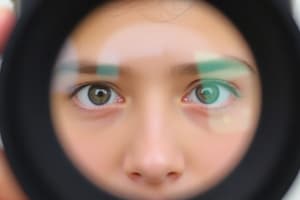Podcast
Questions and Answers
What is the purpose of retinoscopy?
What is the purpose of retinoscopy?
- To determine the patient's refractive error at distance (correct)
- To assess the patient's color vision
- To determine the patient's refractive error at near
- To measure the patient's visual acuity
What is the role of working distance in retinoscopy?
What is the role of working distance in retinoscopy?
- It is important to maintain the working distance steady while performing retinoscopy (correct)
- Working distance is only relevant for subjective refraction
- Working distance does not affect the accuracy of retinoscopy
- Varying working distance enhances the accuracy of retinoscopy
What is the starting point for subjective refraction?
What is the starting point for subjective refraction?
- Subjective refraction
- Patient's visual acuity
- Objective refraction/retinoscopy (correct)
- Final spectacle prescription
What is the function of the optical head of a retinoscope?
What is the function of the optical head of a retinoscope?
What does the concave mirror position in retinoscopy project?
What does the concave mirror position in retinoscopy project?
In retinoscopy, what do the principal meridians correspond to?
In retinoscopy, what do the principal meridians correspond to?
What is the purpose of the break phenomenon in retinoscopy?
What is the purpose of the break phenomenon in retinoscopy?
What is the main difference between with motion and against motion in retinoscopy?
What is the main difference between with motion and against motion in retinoscopy?
What is the skiascopy technique used for in retinoscopy?
What is the skiascopy technique used for in retinoscopy?
When using an optical cross in retinoscopy, what is factored in when recording findings?
When using an optical cross in retinoscopy, what is factored in when recording findings?
What does the gross retinoscopy represent?
What does the gross retinoscopy represent?
What is the net retinoscopy in retinoscopy?
What is the net retinoscopy in retinoscopy?
What is the role of the meridian in retinoscopy?
What is the role of the meridian in retinoscopy?
What does the plano mirror position in retinoscopy project?
What does the plano mirror position in retinoscopy project?
What does the skiascopy technique involve in retinoscopy?
What does the skiascopy technique involve in retinoscopy?
What is the procedure for retinoscopy?
What is the procedure for retinoscopy?
Flashcards
Retinoscopy purpose?
Retinoscopy purpose?
To determine a patient's refractive error at distance.
Working distance role?
Working distance role?
Keep the distance to the patient steady during the exam.
Starting point for subjective refraction?
Starting point for subjective refraction?
Objective refraction/retinoscopy.
Retinoscope optical head function?
Retinoscope optical head function?
Signup and view all the flashcards
Concave mirror position in retinoscopy?
Concave mirror position in retinoscopy?
Signup and view all the flashcards
Principal meridians correspond to?
Principal meridians correspond to?
Signup and view all the flashcards
Purpose of the break phenomenon?
Purpose of the break phenomenon?
Signup and view all the flashcards
Difference between with and against motion?
Difference between with and against motion?
Signup and view all the flashcards
Skiascopy technique used for?
Skiascopy technique used for?
Signup and view all the flashcards
Optical cross factors in?
Optical cross factors in?
Signup and view all the flashcards
What does gross retinoscopy represent?
What does gross retinoscopy represent?
Signup and view all the flashcards
Net retinoscopy?
Net retinoscopy?
Signup and view all the flashcards
Meridian role in retinoscopy?
Meridian role in retinoscopy?
Signup and view all the flashcards
Plano mirror position?
Plano mirror position?
Signup and view all the flashcards
Skiascopy technique involves... ?
Skiascopy technique involves... ?
Signup and view all the flashcards
Procedure for retinoscopy?
Procedure for retinoscopy?
Signup and view all the flashcards
Study Notes
Retinoscopy: Key Points
- The retinoscope uses a fixed bulb system and can create concave or plano mirror effects.
- The concave mirror position projects a more defined streak of light, while the plano mirror position projects a diffuse streak.
- The meridian in retinoscopy refers to the line along which the streak of light is moved, not the position of the streak.
- Principal meridians correspond to orientations that provide the thickest and thinnest reflexes, varying in different refractive errors.
- Break phenomenon is used to determine the principal meridians in an astigmatic eye, while the skew phenomenon involves the streak moving in one direction and the reflex in another.
- Three types of retinoscopy reflex motions exist: with, against, and neutral, each requiring different lens adjustments for neutralization.
- With motion reflex moves in the same direction as the streak, against motion moves in the opposite direction, and neutral motion remains constant as the streak moves across the pupil.
- The skiascopy technique involves using a bar and a fixation target at distance 20/400 with R/G filter, in a dark room to neutralize principal meridian movements.
- The procedure for retinoscopy involves identifying the most plus meridian, neutralizing it first, then neutralizing the second meridian, and recording findings in minus sphero-cylinder form.
- An optical cross is used with loose lenses or skiascopy bars to neutralize both meridians, and the working distance is factored in when recording findings.
- The gross retinoscopy is the initial findings, and the net retinoscopy is the final findings after adjusting for the working distance.
- For example, if neutralizing +3.00 with motion at 180 and +2.00 against motion at 090, the gross retinoscopy would be +3.00-1.00x180, and the net retinoscopy would be +1.00-1.00x180.
Studying That Suits You
Use AI to generate personalized quizzes and flashcards to suit your learning preferences.




